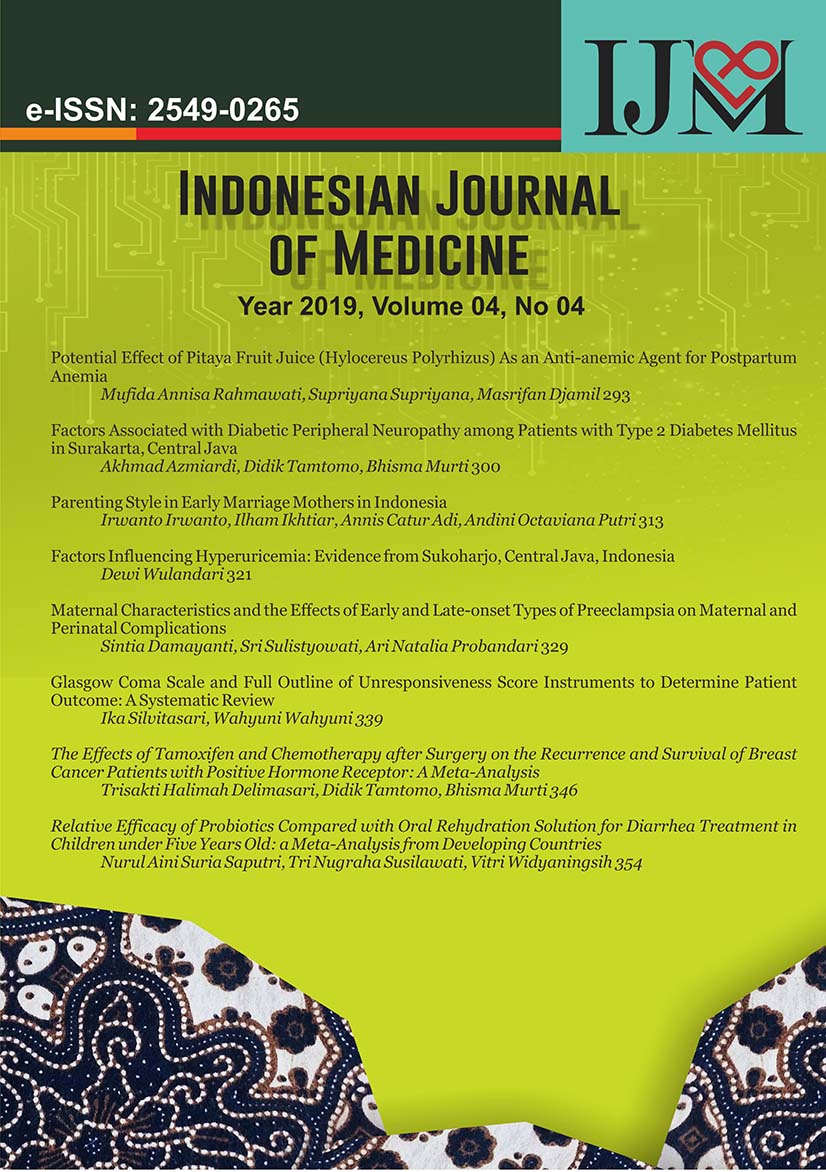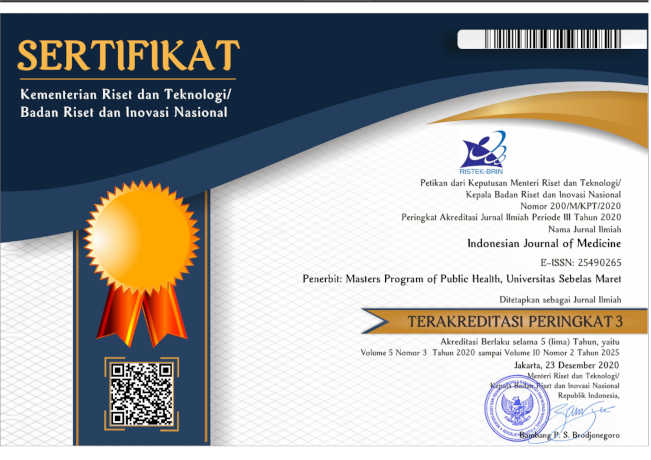Factors Associated with Diabetic Peripheral Neuropathy among Patients with Type 2 Diabetes Mellitus in Surakarta, Central Java
DOI:
https://doi.org/10.26911/theijmed.2019.4.4.217Abstract
Background: Peripheral neuropathy is the most common chronic complication and often occurs in diabetes mellitus. Peripheral neuropathy can cause morbidity, decreased quality of life,and mortality. This study aimed to analyze the determinants of peripheral neuropathy in patients with type 2 diabetes mellitus in Surakarta, Central Java.
Subjects and Method: This study was an observational analytic with cross sectional design. This study was conducted at Surakarta Regional Hospital, Central Java on July 2019. A total of 200 type 2 diabetes mellitus outpatients was selected by simple random sampling. The dependent variable was peripheral neuropathy. The independent variables were age, education level, income, self-efficacy, diet, medication adherence, physical activity, health literacy, duration of illness, and fasting blood sugar. Peripheral neuropathy was measured using the Michigan Neu-black Screening Instrument (MNSI). Other variable data were obtained using questionnaires. Analysis of data used multiple logistic regression.
Results: The risk of peripheral neuropathy increased with age of ≥55 years (b = 3.61; 95% CI = 1.51 to 5.70; p= 0.001), duration of illness ≥ 5 years (b = 2.78; 95% CI = 0.51 to 5.04; p = 0.016 ), and fasting sugar ≥110 mg / dL (b= 1.64; 95% CI= -0.01 to 3.03; p= 0.052). The risk of peripheral neuropathy decreased with education level ≥senior high school (b= -2.41; 95% CI = -4.31 to -0.51; p= 0.013), income ≥ Rp 1,800,000 (b= -1.58; 95% CI= -3.12 to -0.04; p = 0.044), high self-efficacy (b= -1.67; 95% CI= -3.26 to -0.07; p= 0.040), controlled diet (b= -1.89; 95% CI= -3.64 to -0.14; p= 0.034), high medication adherence (b= -2.34; 95% CI= -4.13 to -0.56; p= 0.010), high physical activity (b= -2.33; 95% CI= -4.17 to -0.49; p = 0.013), and high health literacy (b= -1.52; 95% CI = -3.18 to 0.14; p = 0.073).
Conclusion: The risk of peripheral neuropathy increases with age of ≥55 years, duration of illness ≥ 5 years, and fasting blood sugar ≥ 110 mg/dL. The risk of peripheral neuropathy decreases with a high education level, income of ≥1,800,000, high self-efficacy, controlled diet, high medication adherence, high physical activity, and high health literacy.
Keywords: peripheral neuropathy, diabetes
Correspondence: Akhmad Azmiardi. Masters Program in Public Health, Universitas Sebelas Maret, Jl. Ir. Sutami 36 A, Surakarta 57126, Central Java, Indonesia. Email: aazmiardi@gmail.com.Mobile: 085245412021
Indonesian Journal of Medicine (2019), 4(4): 300-312
https://doi.org/10.26911/theijmed.2019.04.04.02
References
Babazadeh T, Dianatinasab M, Daemi A, Nikbakht HA, Moradi F, GhaffariFam S (2017). Association of selfcare behaviors and quality of life among patients with type 2 diabetes mellitus: Chaldoran County, Iran. Diabetes Metab J, 41(6): 449–456. https://doi.org/10.4093/dmj.2017.41.6.449
Bailey SC, Brega AG, Crutchfield TM, Elasy T, Herr H, Kaphingst K, et al. (2014). Update on health literacy and diabetes. Diabetes Educ, 40(5), 581–604. https://doi.org/10.1177/0145721714540220
Budiarti E, Tamtomo DG, Adriani RB (2017). Path analysis on the biopsychosocial determinants of type 2 diabetes mellitus and depression at Dr. Moewardi Hospital, Surakarta. J Epidemiol Public Health, 03(01), 1–14. https://doi.org/10.26911/jepublichealth.2018.03.01.01
Buscemi S, Nicolucci A, Mattina A, Rosafio G, Massenti FM, Lucisano G, et al. (2013). Association of dietary patterns with insulin resistance and clinically silent carotid atherosclerosis in apparently healthy people. Eur. J. Clin. Nutr, 67(12): 1284–1290.https://doi.org/10.1038/ejcn.2013.172
Callaghan BC, Cheng HT, Stables CL, Smith AL, Feldman EL (2012). Diabetic neuropathy: Clinical manifestations and current treatments. Lancet, 11(6): 521–534. https://doi.org/10.1016/S-1474-4422(12)700650
Chahardahcherik S, Gheibizadeh M, Jahani S (2018). The relationship between health literacy and health promoting behaviors in patients with type 2 diabetes, Int J Community Based Nurs Midwifery, 6(1), 65–75
Deli G, Bosnyak E, Pusch G, Komoly S, Feher G (2013). Diabetic neuropathies: Diagnosis and management. Neuroendocrinology, 98(4), 267–280. https://doi.org/10.1159/000358728
Devarajooh C, Chinna K (2017). Depression, distress and selfefficacy: The impact on diabetes selfcare practices. PloS One, 12(3): e0175096. https://doi.org/10.1371/journal.pone.0175096
Dinas Kesehatan Kota Surakarta. (2018). Profil kesehatan kota Surakarta tahun 2017. Dinas Kesehatan Kota Surakarta.
Dinkes Jateng. (2017). Profil kesehatan provinsi Jawa Tengah 2017. Dinkes Jateng. Retrieved from https://doi.org/10.5606/totbid.dergisi.2012.10
Feldman EL, Nave KA, Jensen TS, Bennett DLH (2017). New horizons in diabetic neuropathy: Mechanisms, bioenergetics, and pain. Neuron, 93(6), 1296–1313. https://doi.org/10.1016/j.neuron.2017.02.005
Forbes JM, Cooper ME (2013). Mechanisms of diabetic complications. Am. J. Physiol, 93(1): 137–188. https://doi.org/10.1152/physrev.00045.2011
Friis K, Vind BD, Simmons RK, Maindal HT (2016). The relationship between health literacy and health behavior in people with diabetes: A Danish Population-Based Study. J Diabetes Res, 1–7. https://doi.org/10.1155/2016/7823130
Garoushi S, Johnson MI, Tashani OA (2019). A cross-sectional study to estimate the point prevalence of painful diabetic neuropathy in Eastern Libya. BMC Public Health, 19(1): 78. https://doi.org/10.1186/s1288901863749
Gedik S, Kocoglu D (2018). Selfefficacy level among patients with type 2 diabetes living in rural areas. Rural Remote Health, 18(1), 4262. https://doi.org/10.22605/RRH4262
Huang YM, Shiyanbola OO, Smith PD (2018). Association of health literacy and medication self-efficacy with medication adherence and diabetes control. Patient Prefer Adher, 12, 793–802. https://doi.org/10.2147/PPA.S153312.
International Diabetes Federation (IDF) (2017). Eighth edition 2017. IDF Diabetes Atlas, 8th edition. https://doi.org/http://dx.doi. org/10.1016/S0140-6736(16)316798.
Jaiswal M, Divers J, Dabelea D, Isom S, Bell RA, Martin CL, et al. (2017). Prevalence of and risk factors for diabetic peripheral neuropathy in youth with type 1 and type 2 diabetes: SEARCH for diabetes in youth study. Diabetes Care, 40(9): 1226–1232. https://doi.org/10.2337/dc170179
Jiang J, Qiu H, Zhao G, Zhou Y, Zhang Z, Zhang H, et al. (2012). Dietary fiber intake is associated with HbA1c level among prevalent patients with type 2 diabetes in Pudong New Area of Shanghai, China. PLoS One, 7(10): e46552. https://doi.org/10.1371/journal.pone.0046552
JusterSwitlyk K, Smith AG (2016). Updates in diabetic peripheral neuropathy. F1000Res, 5. Retrieved from https://doi.org/10.12688/f1000research.7898.1
Karki D, Nagila A, Dhakal N, Chhetri S (2018). Prevalence of peripheral neuropathy in diabetes mellitus and its association with therapy, ethnicity and duration of diabetes mellitus. J. Med. Sci, 10(1): 72–76. https://doi.org/10.3126/ajms.v10i1.21743
Kassahun A, Gashe F, Mulisa E, Rike WA (2016). Nona-dherence and factors affecting adherence of diabetic patients to antidiabetic medication in Assela General Hospital, Oromia Region, Ethiopia. J. Pharm. Bioallied Sci, 8(2): 124–129. https://doi.org/10.4103/09757406.171696
Khawaja N, AbuShennar J, Saleh M, Dahbour SS, Khader YS, Ajlouni KM (2018). The prevalence and risk factors of peripheral neuropathy among patients with type 2 diabetes mellitus; the case of Jordan. Diabetol Metab Syndr, 10(8). https://doi.org/10.1186/s1309801803096
Kisozi T, Mutebi E, Kisekka M, Lhatoo S, Sajatovic M, Kaddumukasa M, et al. (2017). Prevalence, severity and factors associated with peripheral neuropathy among newly diagnosed diabetic patients attending Mulago hospital: a cross-sectional study. Afr Health Sci, 17(2), 463. https://doi.org/10.4314/ahs.v17i2.21
Lee TC, Glynn RJ, Peña JM, Paynter NP, Conen D, Ridker PM, et al. (2011). Socioeconomic status and incident type 2 diabetes mellitus: data from the Women’s Health Study. PLoS One, 6(12): e27670. https://doi.org/10.1371/journal.pone.0027670
Masoompour M, Tirgari B, Ghazanfari Z (2017). The Relationship between health literacy, self-efficacy, and self-care behaviors in diabetic patients. Iran J Basic Med Sci, 7(3), 17–25. https://doi.org/10.22038/EBCJ.2017.24826.1551
Meng Y, Bai H, Wang S, Li Z, Wang Q, Chen L (2017). Efficacy of low carbohydrate diet for type 2 diabetes mellitus management: A systematic review and meta-analysis of randomized controlled trials. Diabetes Res Clin Pract, 131, 124–131. https://doi.org/10.1016/J.DIABRES.2017.07.006
Nisar MU, Asad A, Waqas A, Ali N, Nisar A, Qayyum MA, et al. (2015). Association of diabetic neuropathy with duration of type 2 diabetes and glycemic control. Cureus, 7(8), e302. https://doi.org/10.7759/cureus.302
Olesen K, F Reynheim AL, Joensen L, Ridderstråle M, Kayser L, Maindal HT, et al. (2017). Higher health literacy is associated with better glycemic control in adults with type 1 diabetes: a cohort study among 1399 Danes. BMJ Open Diabetes Res Care 5(1), e000437. https://doi.org/10.1136/bmjdrc2017000437
Papanas N, Ziegler D (2015). Risk factors and comorbidities in diabetic neuropathy: An Update 2015. Rev Diabet Stud, 12(1–2): 48–62. https://doi.org/10.1900/RDS.2015.12.48
PopBusui R, Boulton AJM, Feldman EL, Bril V, Freeman R, Malik RA, et al. (2017). Diabetic neuropathy: A position statement by the American Diabetes Association. Diabetes Care, 40(1): 136–154. https://doi.org/10.2337/dc162042
Pranoto HP, Tamtoto D, Murti B (2017). The roles of medical doctor and family on patient health-behavior in controlling HbA1C level among patients with type 2 diabetes mellitus at Dr. Moewardi Hospital. Indones J Med, 02(01), 21–34. https://doi.org/10.26911/theijmed.2017.02.01.03
Prasetyowati U, Tamtoto D, Murti B (2018). Path Analysis: factors associated with self preventive care among patients with type 2 diabetes mellitus in Surkarta. J Health Promot Behav, 03(02): 86–93. https://doi.org/10.26911/thejhpb.2018.03.02.01
Seligman HK, Jacobs EA, López A, Tschann J, Fernandez A (2012). Food insecurity and glycemic control among lowincome patients with type 2 diabetes. Diabetes Care, 35(2): 233–238. https://doi.org/10.2337/dc111627
Sifuentes-Franco S, Pacheco-Moisés FP, Rodríguez-Carrizalez AD, Miranda-Díaz AG (2017). The role of oxidative stress, mitochondrial function, and autophagy in diabetic polyneuropathy. J. Diabetes Res. 1673081. https://doi.org/10.1155/2017/1673081.
Soewondo P, Ferrario A, Tahapary DL (2013). Challenges in diabetes management in Indonesia: a literature review. Global Health, 9: 63. https://doi.org/10.1186/17448603963
Steele CJ, Schöttker B, Marshall AH, Kouvonen A, O’Doherty MG, Mons U, et al. (2017). Education achievement and type 2 diabeteswhat mediates the relationship in older adults? Data from the ESTHER study: a population-based cohort study. BMJ Open, 7(4), e013569. https://doi.org/10.1136/bmjopen2016013569
Suwannaphant K, Laohasiriwong W, Puttanapong N, Saengsuwan J, Phajan T (2017). Association between socioeconomic status and diabetes mellitus: the national socioeconomics survey, 2010 and 2012. J Clin Diagn Res, 11(7), LC18–LC22. https://doi.org/10.7860/JCDR/2017/28221.10286
Tharek Z, Ramli AS, Whitford DL, Ismail Z, Mohd Zulkifli M, Ahmad Sharoni SK, et al. (2018). Relationship between self-efficacy, self-care behaviour and glycaemic control among patients with type 2 diabetes mellitus in the Malaysian primary care setting.BMC Fam Pract, 19(1): 39. https://doi.org/10.1186/s1287501807256
van Dijk JW, van Loon LJC (2015). Exercise strategies to optimize glycemic control in type 2 diabetes: a continuing glucose monitoring perspective. Diabetes Spectr, 28(1): 24–31. https://doi.org/10.2337/diaspect.28.1.24
Vinik AI, Nevoret ML, Casellini C, Parson H (2013). Diabetic neuropathy. Endocrinol Metab Clin North Am, 42(4), 747–787. https://doi.org/10.1016/j.ecl.2013.06.001.
Wang DD, Bakhotmah BA, Hu FB, Alzahrani HA (2014). Prevalence and correlates of diabetic peripheral neuropathy in a Saudi Arabic Population: A Cross-Sectional Study. PLoS One, 9(9). https://doi.org/10.1371/journal.pone.0106935.
Yates T, Griffin S, Bodicoat DH, Brierly G, Dallosso H, Davies MJ, et al.. (2015). Promotion of physical activity through structured education with differing levels of ongoing support for people at high risk of type 2 diabetes (PROPELS): Study protocol for a randomized controlled trial. Trials, 16: 289. https://doi.org/10.1186/s130630150813z











